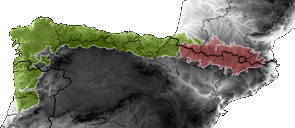Los Pirineos y la Cordillera Cantábrica están sujetos a transformaciones importantes asociadas al cambio climático, como el deshielo de los glaciares, el descenso de la covertura nival, el desplazamiento de especies hacia zonas de mayor altitud, a variaciones fenológicas en las especies, el avance de las fechas de fructificación, etc. En otros casos estos cambios se deben a la actividad humana, como la minería, la expansión de los terrenos urbanizados, el cambio en los usos del territorio, determinadas actividades recreativas, el monocultivo de especies exóticas, etc. Unido a todo ello las áreas montañosas son especialmente sensibles al cambio climático (IPCC, 2007) y proporciona pista de cómo este fenómeno puede afectar a otras regiones.
The Cantabrian territory and Pyrenees are home to high plant diversity and in particular large areas of endemic plant life (plants present within the Cantabrian territory and Pyrenees and neighbouring mountains) which are likely to be affected by these changes and activities.
Plant populations are expected to shift to higher altitudes in response to warming. In fact all over Europe all high mountain species have experienced an altitude increase of 2.7 meters in just seven years, and heat-loving plants (thermophite plants) are overtaking alpine species that are more adapted to cold. It is also important to bear in mind that temperatures are rising faster in mountainous regions, making them particularly vulnerable to climate change.
Ecosystems have an intrinsic ability to adapt, which on many occasions involves moving in search of ideal conditions. However, with high mountain flora this possibility is restricted due to the altitude of Pyrenees and Cantabrian territory, mountains and the fact that the colonisable surface is limited. As plants cannot “climb” any longer because they have reached the top of the mountain this would cause the extinction of those native plants adapted to the cold, like the dwarf willow Salix pyrenaica, Androsace ciliata, Androsace cantabrica or Saxifraga pubescens subsp. iratiana, Leuzea cynaroides, Gentiana burseri, Crepis pyrenaica, Ranunculus pyrenaeus o Geranium cinereum. This will also affect a group of alpine and boreal plants species that have in this area its southern border of distribution and that are refugees in shaded high areas of the mountains like Kobresia myosuroides, Carex capillaris, Silene suecica, Vaccinium gauteroides or Empetrum nigrum. This will also have had negative effects on some species of fauna that depend directly on plants and ecosystems, like bumblebees in the Cantabrian territory.
Plants have a pivotal role in maintaining life on Earth and don’t always get the attention they deserve. Plants are where carbon, nutrients and energy enter ecosystems and provide both physical habitat and the living and dead material that supports the animal food chain.
For all these reasons it is important to gather genetic material for conservation in seed banks of the plants that are most vulnerable to global warming as a preventive conservation measure; to keep monitoring their conservation status; and to research their germination and cultivation requirements, in order to be ready if we need to use them for restoration.
Project purpose
The main purpose of this project is the conservation of an important group of priority plant species (endemic, threatened, protected and rare) through the following objectives:
- To collect seeds of priority plant species in their natural habitats and seeds of keystone species of target habitats in the Cantabrian territory-Pyrenees axis to ensure their long term conservation in seed banks (seed collections).
- To develop and fine tune germination and cultivation protocols for these taxa to ensure their long term conservation in botanical gardens (live plant collections) and to facilitate a successful re-establishment in nature if needed (restoration programmes).
- To disseminate the knowledge gained and the project results, and to make available seed and plant material to stakeholders for use in species and habitat restoration programmes.
- To increase public awareness of the effect of climate change on high mountain flora through plant exhibitions in several botanical gardens.
